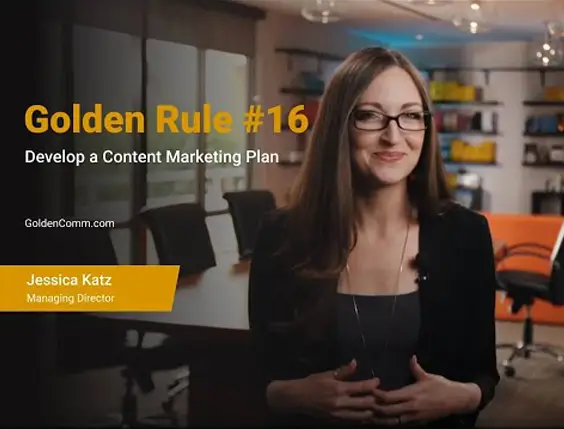

Golden Rule #16 of 20
Develop a Content Marketing Plan
You may have heard the popular marketing adage “Content is King,” but what good is a king without a kingdom? It doesn’t do you any good to create an arsenal of content if you don’t have a comprehensive marketing plan behind it.
Creating a content marketing plan can seem daunting, but if you take it slow and steady, you will have a far-reaching plan of attack before you know it. Here are some initial steps to get moving in the right direction:
- Identify your key areas of strategy and/or unique business offerings.
- Decide what pieces of content you are going to produce for each key area.
- Content Examples:
- Webinars
- Chalk Talks
- Whitepapers
- Solution Papers
- Case Studies
- Comprehensive Infographics
- News Articles
- Blog Posts
- Content Examples:
- Decide the dates for releasing your content.
Eg: Key area 1 will be the focus for Q4- Release a white paper and news article month 1.
- Release a video month 2.
- Release a case study and comprehensive infographic month 3.
Your content calendar should be comprehensive, but leave room for in-the-moment releases.
- Decide what pieces are locked premium content.One of the areas of focus for content is to collect potential leads via forms – see Golden Rule #12: Lock Your Premium Content for detailed information and best practices.
- Integrate with your digital marketing efforts.We cannot stress point number 5 enough. “Synergy” is thrown around a lot as a business buzzword, but the concept of it is spot on. There should be a synergistic approach to all of the moving parts of your business, from content to marketing and sales, and everything in between. As you map out your content marketing plan, take a look at all of your promotional channels and create campaigns around your content. Using something as simple as seasonalized remarketing banners can help your business stay top-of-mind with customers, both repeat and new.
Next to synergy, selecting your content is arguably the most important element of a content marketing plan. If you are going to go heavy on video, be sure you have a clear picture of what you’re going to include in your video marketing. Remember, while video is easily disseminated, it can be detrimental in the long run. Video requires variety in imagery while maintaining consistency in messaging. That’s where it can get tricky. There are a variety of ways to market your product and/or services that position you as a thought leader in your industry. This is why selecting the type of content you’re going to produce and disseminate is critical to your marketing campaign.
Of course, you aren’t going to give the farm away for free. Not when you can easily get something in return for your content. Locking your “premium” content is a great way to capture visitor information. While you don’t have to require a subscription to your content, you could easily include a form that requires readers/visitors to provide a name, email, and any other information you deem significant. This is a great way to increase the number of prospects at the top of your team’s sales funnel, fulfilling the expectation of your marketing plan.
Another key element to your content marketing plan is your strategy for sharing your content. There are varied opinions on best practices for this, but one opinion is constant: using social media can greatly improve the visibility of your content. While there are varying degrees for success based on the type of content (blogs, videos, whitepapers, webinars) that you are looking to share, the fact remains that there is no better, cheaper way to share your content than through social media. Your social media strategy is as important to your content marketing plan as the content itself.
In the end, if you have a strategic content marketing plan that has many elements – including social media and premium content – you are giving yourself the best chance to meet the goals set forth by your marketing department.

